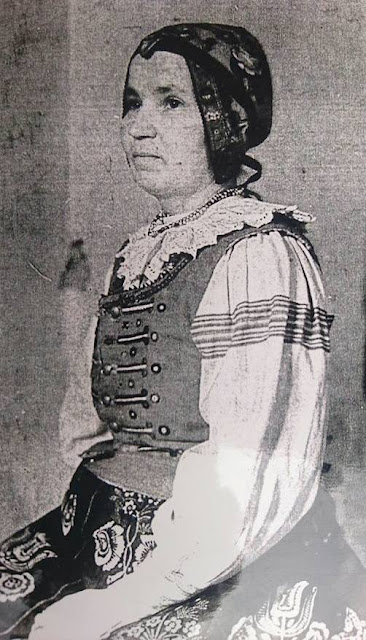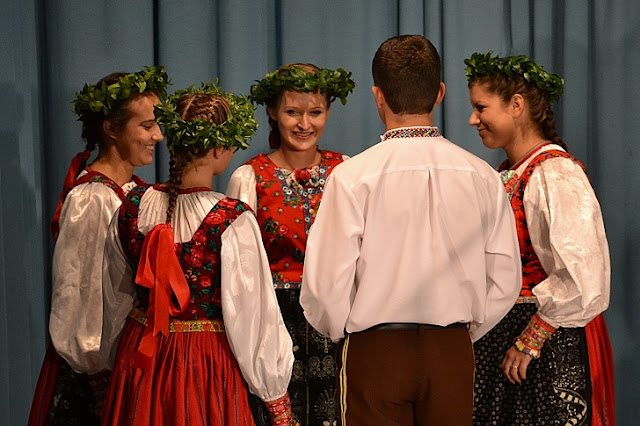Hello all,
I will try to step into this field, fraught with pitfalls as it is, and share the research which I have done, and the work of others from which I have benefited. The Lemko / Rusyns are an East Slavic people, one of the four mountain tribes which inhabit the Carpathians. I Covered the Gorals in my last article. The Lemko / Rusyns live to the east of the Gorals, about to the river San [Sian] in Poland, and to the river Uzh south of the mountains. Here is a map showing the rough extent of these people. This is not completely accurate, as some ethnic islands are omitted, and this extends too far to the east, encroaching on territory actually inhabited by Boikos. This map is useful in that it may be expanded and individual villages found.
The term Lemko was originally a nickname applied to these people in Poland, both by the Polish and the Ukrainians. This was in reference to a common term 'Lem', used in their dialects. This term was not used by the Slovaks, as they also used the word lem. In Slovakia these people call themselves Rusini, Rusnaky, or Rusyns. The term Rusyny, however, is not restricted to this group. Originally all Eastern Slavs who did not inhabit Moscow's empire were called Rusyny, this included the Halychany, the Ukrainians, the Belorussians, etc., as opposed to the Muscovites. [The term 'Russia' was not invented until much later, by Peter Romanov, as part of his naming St. Petersburg as his capitol.] Even today there are people in Ukraine who prefer the term Rusyn. Thus there is no good term, so I will use the term Lemko / Rusyn to refer to this group, recalling that the southern ones do not identify with this term.
This research has many difficulties, chief among them being that the people on the Polish side were the object of Ethnic Cleansing by the Polish government after WWII. They were removed and resettled mostly on lands cleared of former German inhabitants of the west of Poland. There are many objects in Polish and Ukrainian museums, but unfortunately the exact provenance of many of them is unknown. The people on the Slovak side have remained, but are subject to assimilation by the Slovaks.
I wish to present this information because it is hard to find, and is an important part of our Slavic heritage. If you are Rusyn, then please take this in the spirit in which it was intended.
I will present what information I have from west to east. There are areas about which I have discovered nothing, however. This article will cover the westernmost groups, which have some somewhat similar costumes.
The first groups are all characterized by bands of red woven ornament on the womens' shirts.
Osturňa- Остурня
Osturňa - Остурня, along with its sister villages Malá Franková - Мала Франкова, and Veľká Franková - Велика Франкова historically formed the westernmost ethnic enclave of Rusyns. They are found in the Spisz region, between the Polish border and the Slovak Goral village of Ždiar. Here is a map which I used in my last article. This district is the white area in the center of the Spisz region. This lies to the west of the Shliakhtova / Velyky Lypnyk area.
This island is also shown on this map
Today the population of the village calls themselves Slovak on censuses. The costume closely resembles that worn in the Goral village of Ždiar.
The western peninsula
Here is a map of the area. I will be speaking about the region west of the red line. The orange line is the current Poland/Slovakia border.
Shliakhtova - Шляхтова
This group was found on the Polish side and included the villages of Shliakhtova - Шляхтова - Szlachtowa; Chorna Voda -Чорна Вода - Czarna Woda; Bila Voda - Біла Вода - Białawoda; and Jawirki / Явірки / Jaworki . these were in the Rus'ki Potik - Руський Потік -Rusyn Creek river valley which flows into the Dunajec. After WWII the Polish government ethnically cleansed the valley, and replaced the inhabitants with settlers from Podhale. The river was renamed Grajcarek. The folk costume was shared with some Gorals on both the Polish and Slovak sides. It is extremely ornamented.
Note: the term Rus'ki does Not necessarily mean Russian. It refers back to the Rus' 'empire', [it was actually a confederation of city states]. So it refers to any Eastern Slavic people. Those whom we now called Russians, ie part of Moscow's Empire were called Muscovites until the time of Peter Romanov. When he moved the capitol from Moscow to St. Petersburg, [early 1700s] he promoted the term 'Russian' instead. This has been the cause of much confusion.
For more detailed information on this costume and how it compares to neighboring ones, see a couple of my previous articles:
https://folkcostume.blogspot.com/2015/05/costumes-of-pieniny-dunajec-region.html
https://folkcostume.blogspot.com/2015/06/womens-costume-and-embroidery-of.html
https://folkcostume.blogspot.com/2015/07/mens-costume-of-pieniny-dunajec-region.html
Western Rusyns
The four villages of Veľký Lipník, Litmanová, Kamienka, and Jarabina form a group which has a distinct costume, related to that of the Shliakhtova Lemkos. Each village's costume is somewhat distinct, but they form an obvious group.
Veľký Lipník - Великый Липник
This village, with its satellite Stráňany - Страняны, or Folvark - Фільварок, lies just over the ridge of mountains south of Shliakhtova, and had close ties to them, being found on a parallel tributary of the Dunajec. The women's costume is very similar, but the men's is not.The image at the head of the article is from this village.
Here is a song from this area. The middle singer and the two fiddlers are wearing the traditional dress of this village.
https://www.youtube.com/watch?v=mwx_Dsscn6o
A few old photographs from Stráňany - Страняны.
The other three villages lie to the east over another ridge, and lie on the north side of the watershed of the Poprad River. This river flows east in Slovakia and then turns to flow north into Poland. The costumes are more similar to each other. These three villages have retained the woven cuff, but recently have replaced the linen sleeves with damask.
Litmanová - Літманова
This lies the furthest north and is closest to Poland of these three villages, being higher in the mountains. The Litmanova costume is distinguished by trim on the front of the womens' bodices.
Kamienka - Камюнка
This village lies further south, in lower lands than the first. The bodices have a square cut neckline in front, which is trimmed with ribbon.
Jarabina - Орябина
This is the southeasternmost village of this group. The Jarabina bodice has a round cut neckline.
Here is a video of some women singing in the village. This group has performed on Slovakia's version of 'Idol'.
https://www.youtube.com/watch?v=w_IKaVfcxbM
Southwestern Rusyns / Torysky group
This covers the area south of the red line. The villages in this area have a folk costume which is similar to others to the southwest, in the Spiš region. I have found nothing from the three villages in the center which seem not to exist anymore.
Torysky - Ториски
This costume has the points on the bodice which is typical of the Spiš region generally. The embroidery is rich, as indeed is typical of the entire area. The blouse has polychrome embroidery on the cuff, and openwork on the upper sleeve.
Nižné Repaše - Нижні Репаші
This village lies to the east of Torysky. The costume is very similar except for distinct polychrome embroidery on the upper sleeve, at least for unmarried girls. In this first image we see a girl from Torysky on the left, and one from Nižné Repaše on the right.
Oľšavica - Ольшавиця
This is a smaller village even further east. The costume is quite similar. The women's blouse does not seem to be embroidered at all.
Tichý Potok / Тихий Потік
Nižné Repaše -
This village lies in the northeastern part of this area. It was called Štelbach / Штельбах until 1948, and that is how it is labeled on the map above.
A video of the performing group Jalinka from this area. This shows lots of stills and bits of a lot of songs. Some of the images feature costumes of this area.
https://www.youtube.com/watch?v=iKhJmkVj8HI
Ihl'any / Ігляни
This is named Hodermark on the map above. Many of these villages have been renamed. This village is on the western part of these highlands. The traditional attire is similar, but distinct.
I think that may be enough for the first installment, even though I have not covered much territory.
Most of the images were taken from the individual village websites.
I hope that you have found this to be interesting and informative.
Roman K.
email: rkozakand@aol.com



































































































































Do you have costumes from Velky Ruskov (now Slovakia) documented. My family surname is Dziak from that village.
ReplyDeleteAlso, does the village of Cabov (SK) have Rusyn roots?
leema812@gmail.com
Hello Maureen, I had not yet documented the costume from that village. It is now called Nový Ruskov. It seems that the current inhabitants consider themselves Slovak, but from the name of the village and the fact that the church is Greek Catholic, makes it clear that it once was an ethnic island of Rusyns. Here are photos from a village festival there. https://dolnyzemplin.korzar.sme.sk/c/20604847/v-novom-ruskove-oslavili-dni-obce.html
DeleteThe village of Cabov likewise is inhabited by people who consider themselves Slovak, but again, there is a Greek Catholic church in the village. Here is the village website. https://www.cabov.sk/obec/fotogaleria